Shocking : See what NASA has done (Long but worth reading)
9 SPACE ODDITIES:
1. Apollo 14 astronaut Allen Shepard played golf on the Moon. In front of a worldwide TV audience, Mission Control teased him about slicing the ball to the right. Yet a slice is caused by uneven air flow over the ball. The Moon has no atmosphere and no air.
2. A camera panned upwards to catch Apollo 16's Lunar Lander lifting off the Moon. Who did the filming?
3. One NASA picture from Apollo 11 is looking up at Neil Armstrong about to take his giant step for mankind. The photographer must have been lying on the planet surface. If Armstrong was the first man on the Moon, then who took the shot?
4. The pressure inside a space suit was greater than inside a football. The astronauts should have been puffed out like the Michelin Man, but were seen freely bending their joints.
5. The Moon landings took place during the Cold War. Why didn't America make a signal on the moon that could be seen from earth? The PR would have been phenomenal and it could have been easily done with magnesium flares.
6. Text from pictures in the article said that only two men walked on the Moon during the Apollo 12 mission. Yet the astronaut reflected in the visor has no camera. Who took the shot?
7. The flags shadow goes behind the rock so doesn't match the dark line in the foreground, which looks like a line cord. So the shadow to the lower right of the spaceman must be the flag. Where is his shadow? And why is the flag fluttering if there is no air or wind on the moon?
8. How can the flag be brightly lit when its side is to the light? And where, in all of these shots, are the stars?
9. The Lander weighed 17 tons yet the astronauts feet seem to have made a bigger dent in the dust. The powerful booster rocket at the base of the Lunar Lander was fired to slow descent to the moons service. Yet it has left no traces of blasting on the dust underneath. It should have created a small crater, yet the booster looks like it's never been fired.
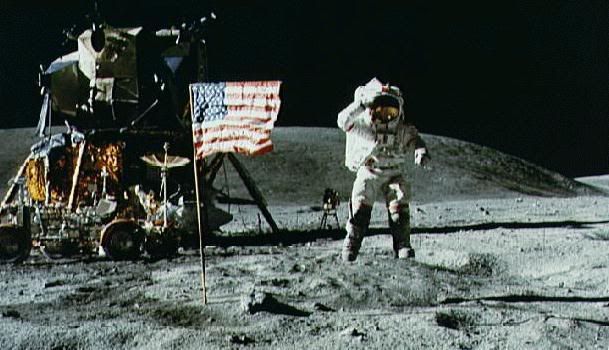
In July 1969, more than 600 million people watched in awe, as Neil Armstrong became the first man to walk on the surface of the moon. The last men to set foot on the moon were the astronauts of Apollo 17, in December 1972. But even before this, a set of conspiracy theories were spreading, the most radical of which claimed that NASA had faked all the lunar landings-that man in fact never landed on the moon. Look at the evidence and decide for yourself.
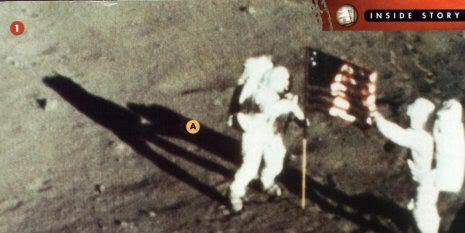
This shot of Neil Armstrong and Buzz Aldrin planting the
US flag on the moon's surface was taken by a 16 mm
camera mounted on the lunar module. Aldrin's shadow (A)
is far longer than Armstrong's. Yet the only light on the
moon - and the only light source used by NASA - comes
from the sun, and should not create such unequal
shadows.
US flag on the moon's surface was taken by a 16 mm
camera mounted on the lunar module. Aldrin's shadow (A)
is far longer than Armstrong's. Yet the only light on the
moon - and the only light source used by NASA - comes
from the sun, and should not create such unequal
shadows.
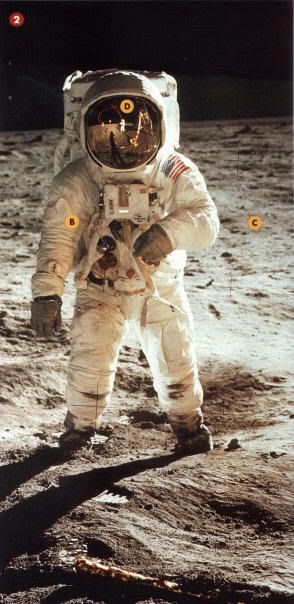
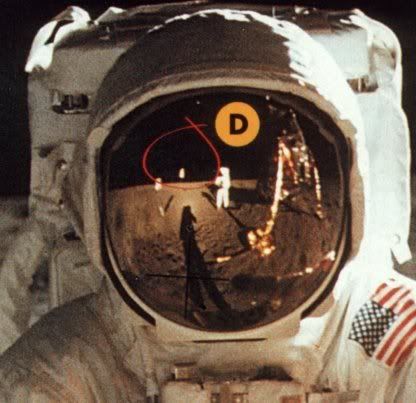
Buzz Aldrin stands with the sun shining down across his left shoulder. Although his right side is in shadow, there is too much detail shown on that side of his space suit (B). It should be much darker and less visible because the contrast between light and dark is much greater on the moon. With no atmosphere to pollute the light on the moon, all the photographs should look bright and crisp. But the landscape behind Aldrin (C) gradually fades to darkness. This 'fall-off' effect, hoax theorists say, should not occur on the moon. But the fading effect could have happened because film is less adaptive than the human eye and makes objects seem darker the further they are from the camera. There is a curious object reflected in Aldrin's visor (D). Some theorists think that it is a helicopter, others say that it is a 12-metre glass structure. NASA claims that it is a piece of equipment on the lunar surface.
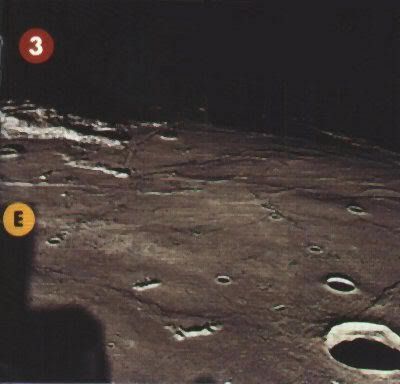
NASA claims the strange shape (E) - in this shot taken from the Lunar Module while it was 95 km above the moon's surface - is a shadow cast by the Command Module's rocket. But when larger aircraft fly at lower altitudes over the Earth, they do not cast such huge and defined shadows.
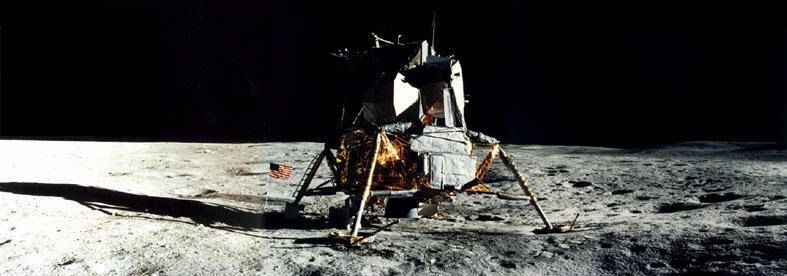
As the Lunar Module Antares, from Apollo 14, rests on the moon's surface there is no crater beneath its feet (F), despite the considerable amount of dust that would have been thrown up during its descent. There also appears to be a footprint (G) directly under the module, yet no one walked on this part of the moon before the craft landed. On the left side of the craft, the words, 'United States' (H) are clearly visible, whereas they should be in shadow. Buzz Aldrin himself said that there is no refracted light on the moon, which points to the fact that another source of light was used to take this shot.
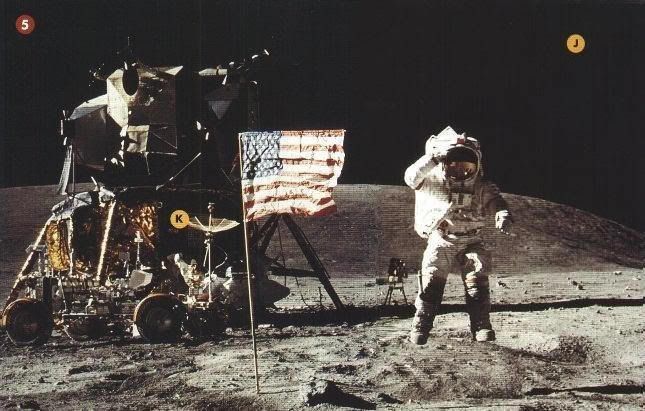

These shots of John Young and James Irwin - like many Apollo photos - show a lunar sky without stars (J). Yet with no atmosphere on the moon, stars should be visible - a fact confirmed by Maria Blyzinsky, Curator of Astronomy at the Greenwich Observatory, London. If NASA could not hope to recreate the lunar sky, they may have opted for simple black backdrops. NASA claim that the sunlight was so strong it overpowered the light from the stars. On the shadow side of the landing modules, there are plaques (K) with the American flag and the words 'United States' quite bright and clearly visible, but the gold foil around the plaques is in near darkness. Studio spotlights highlighting these areas, or technicians retouching the prints, could have caused this effect.
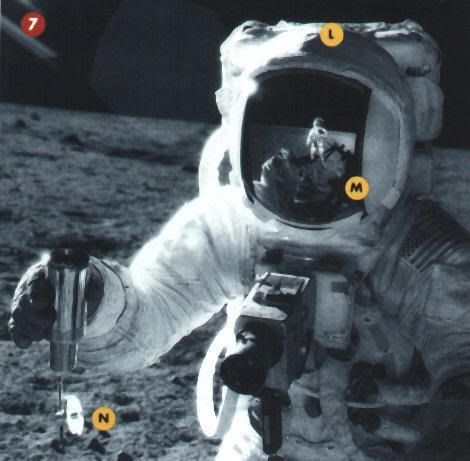
As Alan Bean holds up a Special Environmental Sample Container, the top of his head is clearly in view. But the camera taking the shot was fixed on Charles Conrad's chest, and the ground here seems to be level, so the top of the helmet (L) should not be in the photo. Shadows visible in Al Bean's visor should not be in the photo. Shadows visible in Al Bean's visor (M) go off in various directions, not in straight parallel lines, as expected, suggesting that there is more than one light source. The container Bean is holding (N) is brightly lit at the bottom, yet it is facing away from the light. This may be due to the light reflected from Bean's suit on to the container, but the rest of the container is not so brightly lit.
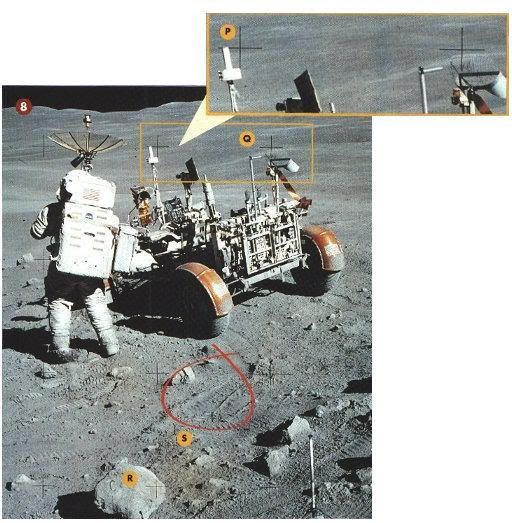
In this photograph of John Young readjusting an antenna next to the Lunar Rover Vehicle (LRV), there is a marker, known as a cross-hair (inset) (P), that goes behind the LRV's equipment. These cross-hairs (Q), which appear on all the lunar photographs, are made by a screen of cross-hairs placed between the shutter and the film. The bright, reflected light may have obliterated the fine line of this one, or it could have happened if the image was retouched. The foreground shows what looks like the letter 'C' on a boulder (R). Is this perhaps an identification letter left on a studio prop? The letter C on the original photo is actually quite well defined and it is hard to imagine what can cause such a well-laid inscription on a boulder in a desolate place such as the moon. The tracks made by the LRV's wheel turn rather oddly at right-angles (S). These tracks could have been caused by studio technicians pushing the buggy into place. Such clear tracks and footprints require moisture to form and should not appear on the dry lunar surface.

No comments:
Post a Comment